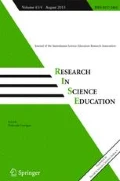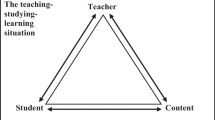Abstract
This paper reports on a large scale study that investigated the quality of teaching and learning in science in Australian schools. Its purposes were first, to describe ideal practice in the teaching and learning of school science; second, to describe the nature of teaching and learning of science in Australian schools; and third, to make recommendations to move the actual closer to the ideal.
Fundamental to the research was the belief that scientific literacy is a high priority for all citizens, helping them to be interested in, and understand the world around them, to be sceptical and questioning of claims made by others about scientific matters, to be able to identify questions, investigate and draw evidence-based conclusions, and to make informed decisions about the environment and their own health and well-being.
Based on national and international reports and research literature, and substantial new data collected from teachers, students and other Australian stakeholders in science education, the ideal picture was described in nine themes relating to the curriculum, teaching and learning strategies, professionalism of teachers and their career path, resources and facilities, and the value of science and science education to the community. The actual picture was one of great variability, but overall, it was bleak. The actual curriculum implemented in most schools differs from the intended curriculum, which is focused on developing scientific literacy and helping students progress towards achieving the stated outcomes. Science in primary schools is generally student-centred and activity-based. When students move to high school, many experience disappointment, because the science they are taught is neither relevant nor engaging and does not connect with their interests and experiences. Disenchantment with science is reflected in the decline in science subjects taken by students in upper secondary school. Many science teachers feel undervalued, under-resourced and overloaded with non-teaching duties.
The recommendations developed to improve the status and quality of science education were underlain by five fundamental premises: the purpose of science education is to develop scientific literacy, the focus for change is closing the gap between the actual and ideal, teachers are the key to change, change takes time and resources, and collaboration is essential for quality science education. Preliminary recommendations were prepared and scrutinised by members of a government-appointed Steering Committee for the project, critical friends, and teacher focus groups. Recommendations concerning awareness, teachers, resources, assessment, and national collaboration were developed incorporating feedback from the process described, each including a range of suggested actions for implementation that were feasible in the Australian context. If Commonwealth and State governments choose to act on these recommendations, the gap between the actual picture of science teaching and learning in Australia and the ideal will be significantly reduced.
Similar content being viewed by others

References
Australian Bureau of Statistics. (1999). Schools, Australia, preliminary: ABS catalogue number 4220.0. Canberra: Australian Bureau of Statistics.
Australian Council of Deans of Education. (2000). Submission to the teaching and learning of science project. Canberra: Author.
Australian Science Teachers Association (ASTA). (1985). Science in Australian schools: Today's problems and tomorrow's challenges. Canberra: Author.
Australian Science, Technology and Engineering Council (ASTEC). (1997). Foundations for Australia's future: Science and technology in primary schools. Canberra: Australian Government Publishing Service.
Baird, J. R., Gunstone, R. F., Penna, C., Fensham, P. J., & White, R. T. (1990). Researching balance between cognition and affect in science teaching and learning. Research in Science Education, 20, 11-20.
Black, P. (1995). 1987 to 1995–The struggle to formulate a national curriculum for science for England and Wales. Studies in Science Education, 26, 159-188.
Black, P., & Wiliam, D. (1998). Assessment and classroom learning. Assessment in Education, 5(1), 7-74.
Bybee, R. W. (1997). Achieving scientific literacy: From purposes to practical action. Portsmouth, NH: Heinemann.
Bybee, R. W., & DeBoer, G. (1994). Research on the goals for science education. In D. L. Gabel (Ed.), Handbook of research on teaching and learning of science (pp. 357-387). New York: Macmillan.
Collins, A. (1995). National Science Education Standards in the United States: A process and a product. Studies in Science Education, 26, 7-37.
Council for Science and Technology. (2000). Science teachers: A report on supporting and developing the profession of science teaching in primary and secondary schools. London: Author.
Curriculum Corporation. (1994a). A statement on science for Australian schools. Melbourne: Author.
Curriculum Corporation. (1994b). Science–A curriculum profile for Australian schools. Melbourne: Author.
Curriculum Council. (1998). Curriculum framework for kindergarten to Year 12 in Western Australia. Perth, Western Australia: Author.
Darling-Hammond, L. (2000). Teaching quality and student achievement: A review of State Policy evidence. Education Policy Analysis Archives, 8(1). URL http://epaa.asu.edu/epaa/v8nl
DeBoer, G. E. (2000). Scientific literacy: Another look at its historical and contemporary meanings and its relationship to science education reform. Journal of Research in Science Teaching, 37, 582-601.
Dekkers, J., & De Laeter, J. R. (2001). Enrolment trends in school science education in Australia. International Journal of Science Education, 23, 487-500.
Dekkers, J., & De Laeter, J. R. (1997). The changing nature of upper secondary school science subject enrolments. Australian Science Teachers Journal, 43(4), 35-41.
Dillon, J., Osborne, J., Fairbrother, R., & Kurina, L. (2000). A study into the professional views and needs of science teachers in primary and secondary schools in England. London: Council for Science and Technology.
Dircks, R. (1985). The place of science in the K-12 curriculum of Australian schools. Canberra: Australian Science Teachers Association.
Dobson, I. R., & Calderon, A. J. (1999). Trends in science education: Learning, teaching and outcomes 1989–1997. Melbourne: Australian Council of Deans of Science.
Fensham, P. J. (1985). Science for all: A reflective essay. Journal of Curriculum Studies, 17, 415-435.
Fensham, P. J. (1997). School science and its problems with scientificliteracy. In R. Levinson, & J. Thomas (Eds.), Science today: Problem or crisis? London: Routledge.
Fensham, P. J. (1998). Primary science and technology in Australia: A discussion paper and comparative perspective (Key Centre Monograph No 7). Perth: Curtin University of Technology, Key Centre for School Science and Mathematics.
Fensham, P. J. (1999). Science content as problematic: Issues for research. The Rosalind Driver Memorial Lecture presented at the second meeting of the European Science Education Research Association, Kiel, Germany.
Gibbs, W. W., & Fox, D. (1999). The false crisis in science education. Scientific American, October, 87-92.
Goodrum, D., Hackling, M., & Rennie, L. (2000). The status and quality of teaching and learning of science in Australian schools: A research report. Canberra: Department of Education, Training and Youth affairs.
Hackling, M. W. (1998). Working scientifically: Implementing and assessing open investigation work in science. Perth: Education Department of Western Australia.
Harmon, M., Smith, T. A., Martin, M. O., Kelly, D. L., Beaton, A. E., Mullis, I. V. S., Gonzales, E. J., & Orpwood, G. (1997). Performance assessment in IEA's third international mathematics and science study (TIMSS). Chestnut Hill, MA: International Association for the Evaluation of Educational Achievement.
Ingvarson, L., & Wright, J. (1999). Science teachers are developing their own standards. Australian Science Teachers Journal, 45(4), 27-34.
Jenkins, E. W. (1992). School science education: Towards a reconstruction. Journal of Curriculum Studies, 24, 229-246.
Lokan, J., Ford, P., & Greenwood, L. (1996). Maths and science on the line: Australian junior secondary students' performance. Third International Mathematics and Science Study. Melbourne: Australian Council for Educational Research.
Lokan, J., Ford, P., & Greenwood, L. (1997). Maths and science on the line: Australian middle primary students' performance. Third International Mathematics and Science Study. Melbourne: Australian Council for Educational Research.
Martin, M. O., Mullis, I. V. S., Gonzales, E. J., Gregory, K. D., Smith, T. A., Chrostowski, S. J., Garden, R. A., & O'Connor, K. M. (2001). TIMSS 1999 international science report: Findings from IEA's repeat of the third international mathematics and science study at the eighth grade [WWW document]. URL http://isc.bc.edu/timss1999i/science_achievement_report.html
Ministerial Council on Education, Employment and Youth Affairs (MCEETYA). (1999). Australia's common and agreed National Goals for Schooling in the twenty-first century. Curriculum Perspectives, 19(4), 8-9.
Millar, R. (1996). Towards a science curriculum for public understanding. School Science Review, 77(280), 7-18.
Millar, R., & Osborne, J. (1998). Beyond 2000: Science education for the future (The report of a seminar series funded by the Nuffield Foundation). London: King's College London, School of Education.
National Science Council. (1996). National science education standards. Washington, DC: National Academy Press.
NSW Board of Studies. (1998). Science stages 4–5: Syllabus. Sydney: Board of Studies NSW.
OECD Programme for International Student Assessment (OECD/PISA). (1999). Measuring student knowledge and skills: A new framework for assessment. Paris: OECD.
Osborne, J., & Simon, S. (1996). Primary science: Past and future directions. Studies in Science Education, 27, 99-147.
Rennie, L. J., Fraser, B. F., & Treagust, D. F. (1999). Research in science education. In J. P. Keeves, & K. Marjoribanks (Eds.), Australian education: Review of research 1965–1998 (pp. 171-203). Melbourne: Australian Council for Educational Research.
Roberts, D. (1982). Developing the concept of “curriculum emphasis.” Science Education, 66, 243-260.
Roberts, D. (1998). Why in the world are students learning science? Studies in Science Education, 32, 113-123.
Sadler, D. R. (1989). Formative assessment and the design of instructional systems. Instructional Science, 18, 119-144.
Select Committee on Science and Technology. (2000). Science and technology–Third report. London: House of Lords, Science and Technology Committee Publications.
Speering, W., & Rennie, L. (1996). Students' perceptions about science: The impact of transition from primary to secondary school. Research in Science Education, 26, 283-298.
Staer, H., Goodrum, D., & Hackling, M. (1998). High school laboratory work in Western Australia: Openness to inquiry. Research in Science Education, 28(2), 219-228.
Yates, S., & Goodrum, D. (1990). How confident are primary school teachers in teaching science? Research in Science Education, 20, 300-305.
Author information
Authors and Affiliations
Rights and permissions
About this article
Cite this article
Rennie, L.J., Goodrum, D. & Hackling, M. Science Teaching and Learning in Australian Schools: Results of a National Study. Research in Science Education 31, 455–498 (2001). https://doi.org/10.1023/A:1013171905815
Issue Date:
DOI: https://doi.org/10.1023/A:1013171905815



